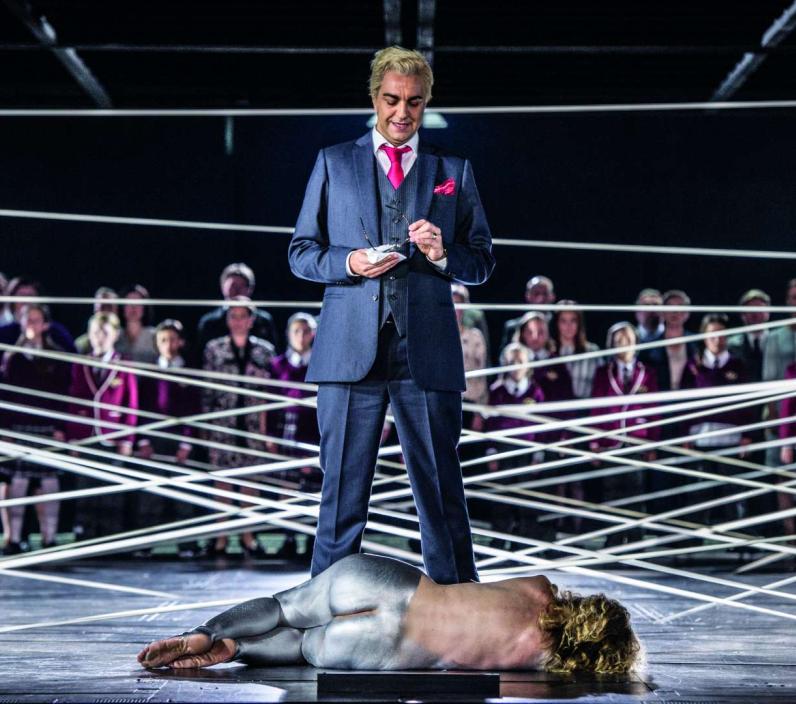

Tosca is an opera that will always be contemporary, as it expresses fundamental archetypes of the human condition: ruthless power grabbers, idealist revolutionaries and strong women ready to sacrifice it all. And this is even clearer under Calixto Bieito’s direction.
Calixto Bieito invites us to a world of ruthless power grabbers, idealist revolutionaries and strong women ready to sacrifice it all.
Cast
Floria Tosca, singer | Svetlana Aksenova |
|---|---|
Mario Cavaradossi, artist | Daniel Johansson |
Scarpia, chief of police | Claudio Sgura |
Cesare Angelotti | Jens-Erik Aasbø |
'Il Sagrestano' | Pietro Simone |
Sciarrone, Scarpia's agent | Ludvig Lindström |
Spoletta, Scarpia's agent | Thorbjørn Gulbrandsøy |
Eduardo, Scarpia’s son | Aksel Johannes Skramstad Rykkvin |
Chorus | Norwegian National Opera Chorus |
Orchestra | Norwegian National Opera Orchestra |
| ... | |
Music | Giacomo Puccini |
|---|---|
Conductor | Karl-Heinz Steffens |
Director | Calixto Bieito |
Sets | Susanne Gschwender |
Lighting | Michael Bauer |
Costumes | Anja Rabes |
Text | Luigi Illica, Giuseppe Giacosa |
| ... | |
Video
The story
Tosca is an opera that will always be contemporary, as it expresses fundamental archetypes of the human condition: ruthless power grabbers, idealist revolutionaries and strong women ready to sacrifice it all.
Tosca takes place in the year 1800 in Rome, at a time of political upheaval and unrest.
In the first act, the action takes place inside the church of Santa Maria della Valle. Cesare Angelotti, former consul of the decayed Republic of Rome, has managed to escape from prison and has found refuge in the church where his sister Marchioness Attavanti has left him some clothes in the family chapel. Elsewhere in the church, the painter Mario Cavaradossi is working on a portrait of Mary Magdalene: he compares the angelical features of the painting to the dark, sensual ones of his lover Tosca (ʽRecondita armoniaʼ). Once alone, Angelotti comes up to Cavaradossi, as they are friends and they both fought for the Republic. An imperious voice resonates in the church: it’s Floria Tosca, the great singer and Cavaradossi’s lover. Tosca is jealous and believes that she heard a woman’s voice in the church, and she is also highly suspicious of the painting of Mary Magdalene, in which she recognises the likeness of the Marchioness. Cavaradossi manages to appease her and arranges for them to meet at their usual place later in the evening (ʽNon la sospiri, la nostra casettaʼ).
Meanwhile, police have discovered Angelotti’s escape. Cavaradossi offers Angelotti a hiding place in his country cottage, and both leave at once. Napoleon has been defeated; people gather in the church to celebrate. They are interrupted by the Papal Chief of Police, Scarpia: he finds a fan belonging to the Marchioness and learns that Cavaradossi has disappeared, which leads him to think that he has a role in Angelotti’s prison break.
Tosca returns to the church only to find out that Cavaradossi has left. Furious, she is an easy prey for Scarpia, who stirs up her jealousy by showing her the Marchioness’s fan. She storms out heading to her lover’s cottage, unaware that Spoletta, Scarpia’s henchman, is following her. Scarpia has devised a cruel, but cunning plan: he wants to have Cavaradossi executed and make Tosca his own lover. He exclaims: 'Tosca, you make me forget even God!' while the Te Deum, a Christian hymn of praise, is resonating in the church.
The second act opens in Scarpia’s office, in Palazzo Farnese. While enjoying supper, and listening to Tosca singing for the Queen elsewhere in the palace, he savours in advance the success of his plan. Cavaradossi is brought in by Spoletta: he denies knowing Angelotti. Tosca rushes in, as she has been informed by Scarpia. Cavaradossi tells her not to speak, and is taken to a neighbouring room where he is tortured. Tosca, unable to withstand the cries of her lover, gives in and reveals Angelotti’s hiding place.
A messenger enters, with news that Napoleon has won the Marengo battle: Cavaradossi is dragged in, and sings a hymn to freedom before he is taken to prison. Spoletta informs that Angelotti has committed suicide. Scarpia explains that the price for Cavaradossi’s release from political imprisonment is Tosca herself. Tosca reluctantly accepts (ʽVissi d’arteʼ). Scarpia gives the order that the Cavaradossi’s execution be simulated, and prepares a diplomatic passport for Tosca and Cavaradossi so that they can flee Rome. While he tries to kiss her, Scarpia is stabbed by Tosca. Looking at the Scarpia’s body, Tosca disdainfully exclaims: ‘Before him all Rome trembled!’
The third act opens on the roof of Castel Sant’Angelo, at dawn. It is the day of Cavaradossi’s execution; his last thoughts are for Tosca (ʽE lucevan le stelleʼ). She comes in, informing him that the execution will only be simulated, and that they will escape Rome together. The firing squad aligns, and Tosca tells him to act as if he was really shot. After the shooting, she runs towards Cavaradossi, only to find that he is really dead, and that Scarpia has betrayed her. Scarpia’s body has been found and Spoletta arrives to arrest Tosca. Instead of surrendering, she decides to jump into the void crying ‘O Scarpia, we meet before God!’
Insights
1800 (year the action takes place); 1900 (the year Tosca premiered); today. Rome versus anywhere. In common: power, oppression, the role of the artist, revolution. Catalan enfant terrible Calixto Bieito has set to break the mould of the traditional takes on Tosca. Known for his challenging, graphic, and revolutionary interpretation of opera, Bieito aims to release the characters from the operatic clichés while retaining their symbolic, universal power.
Bieito’s production focuses on the interaction between the three main protagonists, stripped to its essential. He has worked intensively on creating individual inward journeys for the protagonists: Tosca will move from ingenue lover to political activist fighting the oppressive power to revolutionary in the third act. Accordingly, the stage design is reduced to its core, freeing the protagonists from specific constraints in time and space.


